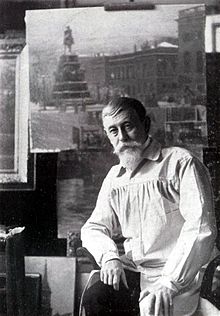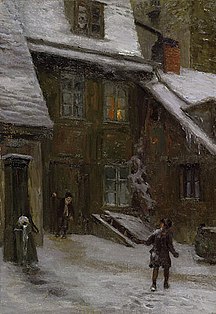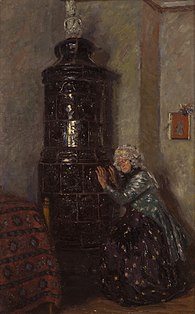
Franz Moritz Wilhelm Marc was a German painter and printmaker, one of the key figures of German Expressionism. He was a founding member of Der Blaue Reiter, a journal whose name later became synonymous with the circle of artists collaborating in it.

Max Liebermann was a German painter and printmaker, and one of the leading proponents of Impressionism in Germany and continental Europe. In addition to his activity as an artist, he also assembled an important collection of French Impressionist works.
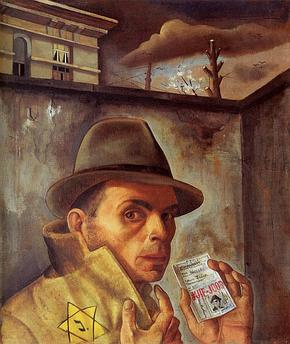
Felix Nussbaum was a German-Jewish surrealist painter. Nussbaum's work gives insights into the essence of one person among the victims of the Holocaust.

In art history, secession refers to a historic break between a group of avant-garde artists and conservative European standard-bearers of academic and official art in the late 19th and early 20th century. The name was first suggested by Georg Hirth (1841–1916), the editor and publisher of the influential German art magazine Jugend (Youth), which also went on to lend its name to the Jugendstil. His word choice emphasized the tumultuous rejection of legacy art while it was being reimagined.

Adolph Friedrich Erdmann von Menzel was a German Realist artist noted for drawings, etchings, and paintings. Along with Caspar David Friedrich, he is considered one of the two most prominent German painters of the 19th century, and was the most successful artist of his era in Germany. First known as Adolph Menzel, he was knighted in 1898 and changed his name to Adolph von Menzel.

Otto Müller was a German painter and printmaker of the Die Brücke expressionist movement.

Nazi plunder was the stealing of art and other items which occurred as a result of the organized looting of European countries during the time of the Nazi Party in Germany.

Johannes Martini was a German oil painter and graphic artist.
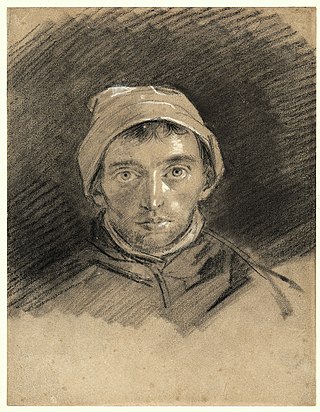
Franz Krüger, known as Pferde-Krüger ("Horse-Krüger"), was a German (Prussian) painter and lithographer. He was best known for his romantic and lively portraits and pictures of horses, which made him the most in demand military and portrait painter in Berlin. His paintings of military parades and hundreds of portraits led to him painting many of the "well to do" of the city.

Gunter Demnig is a German artist. He is best known for his Stolperstein memorials to the victims of Nazi persecution, including Jews, homosexuals, Romani and the disabled. The project places engraved brass stones in front of a former residence for a Holocaust victim who was deported and murdered by Nazi Germany. The memorial effort began in Germany and has since spread, with more than 100,000 stones placed across 26 countries in Europe.

Hildebrand Gurlitt was a German art historian and art gallery director who dealt in Nazi-looted art as one of Hitler's and Goering's four authorized dealers for "degenerate art".

The Gurlitt Collection was a collection of around 1,500 art works assembled by Cornelius Gurlitt, the son of one of Hitler's official art dealers, Hildebrand Gurlitt (1895–1956), and which was found to have contained several artworks looted from Jews by the Nazis.

Rolf Nikolaus Cornelius Gurlitt was a German art collector. The son of Hildebrand Gurlitt, a Nazi-era dealer of looted art, Gurlitt was discovered to have concealed a stash of artworks known as the Gurlitt trove or Gurlitt Collection, several of which have been proven to have been looted from Jews by Nazis.

Paul Friedrich Meyerheim was a German painter and graphic artist. He did portraits and landscapes, but is best known as a painter of animals.
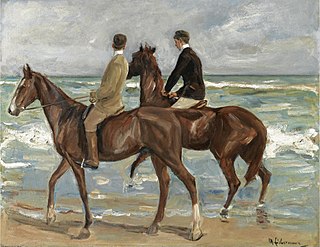
Two Riders on the Beach is the title of two similar paintings by the German artist Max Liebermann. Both were painted in 1901 while Liebermann was on vacation in Scheveningen on the North Sea. The paintings are considered masterpieces of German impressionism, heavily influenced by the style of French impressionist painters Édouard Manet and Edgar Degas.

Friedrich "Fritz" Gurlitt, originally from Vienna, was a Berlin based art dealer and collector, specialising, in particular, in contemporary art. After his early death the art gallery he had established in central Berlin was taken on by his son, the dealer Wolfgang Gurlitt (1888-1965).
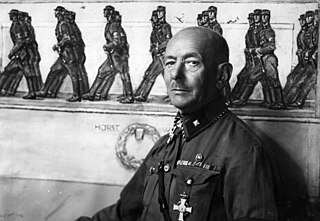
Ludwig Julius Christian Dettmann was a German Impressionist painter. Shortly before his death, he was added to the Gottbegnadeten list, a roster of artists considered crucial to Nazi culture.
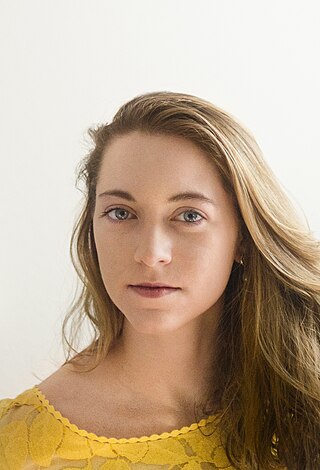
Mary MacPherson Lane is an American non-fiction writer and journalist specializing in Western European art and history.
Max Schlichting was a painter of German Impressionism. Schlichting, who also worked as a professor and art official, is known for French subjects and depictions of landscapes in Flanders and the Netherlands.

Große Berliner Kunstausstellung , abbreviated GroBeKa or GBK, was an annual art exhibition that existed from 1893 to 1969 with intermittent breaks. In 1917 and 1918, during World War I, it was not held in Berlin but in Düsseldorf. In 1919 and 1920, it operated under the name Kunstausstellung Berlin. From 1970 to 1995, the Freie Berliner Kunstausstellung was held annually in its place.
